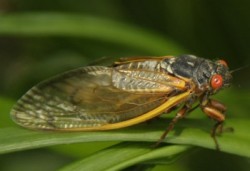
Brood XIX emerges for the first time in 13 years
Vanderbilt commencement speakers may have some unusual competition this year: Nashville’s largest brood of cicadas are predicted to emerge in May and hang around for about five or six weeks.
Besides their practice of appearing on 13- to 17-year cycles, cicadas are best known for the buzzing and clicking sounds that they make, which can be amplified by the sudden emergence of millions of the insects into an overpowering din.
Adult cicadas are black to dark brown in color with transparent wings. They are more than an inch long with a wingspan of three inches and have bright red eyes. Males are responsible for the noise, which they produce by vibrating ridged membranes on their abdomens, which are hollow so they amplify the scritching sounds. When you think about it, cicadas are perfect insects for Music City because they do not sting or bite: All they do is make a lot of noise.
This crop of cicadas, known as Brood XIX, operates on a 13-year cycle and last emerged in May 1998. According to news reports from the period, the racket that the brood made was memorable.
There are some 100 species of cicadas in North America, but only a few share the penchant for disappearing entirely for many years, only to reappear in force at a regular intervals. Those that don’t are called annuals because some adults appear every year even though individuals have multi-year lifecycles.
During their brief period above ground, female cicadas make a groove in a tree limb where she lays her eggs. When young cicada nymphs hatch they head for the ground and burrow in. They spend their early life stages in underground burrows feeding on plant roots before surfacing as adults.
Despite the fact that large cicada broods can produce populations of tens or hundreds of thousands of insects per acre, they do remarkably little damage. Large broods can overwhelm and damage young trees by feeding and laying eggs, but older trees usually escape without serious damage.
During the last emergence, Vanderbilt mathematician Glenn Webb got interested in the question of why cicadas emerge only at intervals that are prime numbers. Intrigued by paleontologist Stephen Jay Gould’s proposition that these intervals must have an evolutionary advantage, Webb created a model with periodic cicadas and hypothetical predators on two- and three-year life cycles. He found that by emerging every 13 or 17 years the cicadas better ensured their survival.
Check out the Cicadia Mania website for more information.